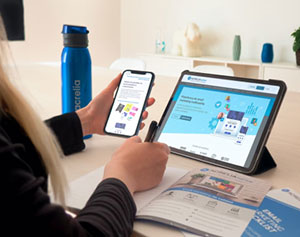84% of B2B Buyers Prefer Omni-Channel: 4 Ways to Execute It Successfully

Blog post By Paula Chiocchi on 2025-03-26
Today, data-driven insights allow marketers to customize every aspect of their omni-channel campaigns—from audience selection to channel activation and creative messaging. And research shows why it matters:
Companies with strong omni-channel strategies retain 89% of their customers, compared to just 33% for companies with weak omni-channel engagement. (Source: Porch Group Media)
In 2025, there is a clear expectation for omni-channel experiences, with 84% of B2B buyers stating that it is essential for sellers to operate across multiple online and offline channels. (Source: Hokodo, the B2B Ecommerce Association, and Greenwood Consulting)
At OMI, we’ve spent years refining custom omni-channel solutions that align with real audience behaviors, expectations, and business goals. Following a recent podcast conversation on omni-channel marketing with Keith Goodman, VP of Corporate Sales and Marketing for Modern Postcard, I thought it would be timely to share four secrets to our success, including a few real-world examples.
1. Build Campaigns Around Your Ideal Customer Profile (ICP)
Effective omni-channel marketing starts with a clearly defined ICP—a carefully thought-out description of the types of companies and decision-makers most likely to engage with your brand.
How to define your ICP:
- Analyze current and past customers to identify shared characteristics.
- Look at industry, company size, job titles, and buying behaviors.
- Use real data insights rather than assumptions.
For acquisition campaigns (a specialty of ours at OMI), a strong ICP helps you map out data sources and media channels effectively. No roadmaps are identical, but each one should align with your ICP and business objectives. Go here to read our recent blog on how to build a modern and robust ICP.
2. Choose and Sequence the Right Channels
Omni-channel doesn’t mean being everywhere—it means being where your audience actually engages. When we spoke with Keith, he talked about testing the sequencing of media to see where and how to achieve the best results for a campaign. Modern Postcard leverages the benefits of each type of media to maximize the response and the conversion.
Direct mail plays very well with digital and email, Keith says. For example, postal retargeting is a big focus for his company. They can identify a postal address based on a cookie to a web visitor and then send direct mail to bring that visitor back to the website or move them into a conversion media, from phone calls to catalog orders or something else.
Also, when people respond to a direct mail piece, you can then send them an email and hit them with digital ads. By combining these media in different sequences based on specific activities, you can drive them to certain activities that move them along the funnel in purchasing. When you combine and sequence media in this way, you gain a powerful way to target with greater accuracy.
Example: A consumer-focused brand needed to pilot a new acquisition campaign targeting small businesses. OMI leveraged B2C data through an identity graph, defining a specialized audience of sole proprietors and businesses with 1-4 employees. Triggered email and programmatic ads created a seamless experience across channels, reinforcing brand messaging and increasing engagement.
Key takeaway: More channels don’t always mean better results. Instead of spreading thin, invest in a strategic mix of channels that match your ICP and goals and test out sequencing to determine the best mix.
3. Prioritize Personalization and Precision Targeting
A modern omni-channel strategy isn’t just about reaching people—it’s about reaching the right people with the right message at the right time. An interesting point about using AI to deliver on this promise came up during the podcast conversation with Keith. He mentioned that his company relies upon OpenAI to generate a list of targets for some clients and to append the domains of those targets. Then, leveraging their data team, they structure that list for integration into an ABM program, resulting in a ready-to-use custom audience.
Keith will also turn to OMI to drill down further after uncovering a list of companies that engaged with a client campaign. OMI will deliver more attributes for the prospects in that list, providing clients with a robust profile for improved personalization and targeting.
The bottom line is that success in every omni-channel campaign requires robust, high-quality contact data, which is our core service at OMI. We enable our clients to reach their most ideal prospects across their target markets using our massive Living File® B2B database, containing 145 million+ manager-, director-, and professional-level and above contacts with email/HEM, social URL, and other attributes. We also offer add-on techniques—like B2B2C matching to theTradeDesk and top social platforms, along with intent data—for more precise targeting (for ad serving and other purposes) and improved campaign performance.
4. Use Modern Omni-Channel Attribution & Measurement
A recent eMarketer survey states, "Most marketers (78.4%) use last-click attribution and web analytics to measure media efficacy.” This metric attributes full credit of a conversion to the last ad a user clicked on before converting. But “despite common reliance, most are displeased with last-click attribution.” They need measurement that reflects the entire customer journey, not just the last click.
To optimize advertising measurement and understand how campaigns are performing at every step, our perspective is that marketers need a trusted agency partner. The right partner can guide you in your media choices and ensure you avoid the pitfalls of ad fraud and poor audience data, which negatively impact measurement accuracy. With OMI’s custom audience services, you can track activity across multiple digital channels.
Right now, we are loving the possibilities offered by connected TV (CTV), which is leading the way in modern marketing measurement (check out our recent blog on the rise of CTV advertising) by providing:
- Conversion tracking: Identify website visitors and determine which ones made a purchase after viewing an ad.
- Footfall attribution: Measure how many viewers visited a physical location following an ad exposure.
Measurement capabilities like this make it easier to calculate ROI, and that’s what marketers need more than ever today.
Need a smarter omni-channel strategy? Contact OMI at request@outwardmedia.com for a consultation on custom audience building, data-driven customer acquisition solutions, and campaign execution at scale.
DOWNLOAD YOUR FREE ebook
At OMI, we believe good things happen when you share your knowledge. That's why we're proud to educate marketers at every level - in every size and type of organization - about the basics of email marketing and the contact data that powers it.
-
The Executive's 15-Minute Guide to Building a Successful Email Marketing Database
-
A 15-Minute Guide to Fortune 2,000 Businesses and Executives
-
Five Best Practices for Using Email Marketing to Target SMBs



